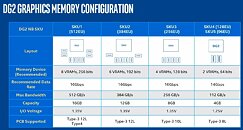
Intel Arc "Alchemist" Desktop Graphics Cards Launch Pushed to Late-June/July
Supply issues seem to continue to affect Intel's ambitious desktop GPU launch plans, with the Arc "Alchemist" line of desktop discrete GPUs now launching at "late Q2 or early Q3," sources tell VideoCardz. This would put the launch toward the end of June, or some time in July. This follows a similar trend with availability of notebooks powered by Arc "Alchemist" discrete GPUs, which are expected to be available in June, despite a March product launch.
A mid-year launch risks putting Intel's nascent dGPU lineup perilously close to AMD's RX 6x50 refresh, and NVIDIA's RTX 40-series "Ada Lovelace" graphics cards, expected to debut across the second half of 2022. At launch, Intel's desktop graphics card lineup will include as many as five SKUs, including the Arc A380, the Arc A580, the Arc A770, and the flagship Arc A780, which is probably a Limited Edition SKU. With the rumored performance numbers we're seeing, These SKUs have the potential to impress gamers, provided they aren't obsolete at launch by next-generation models from NVIDIA and AMD.
A mid-year launch risks putting Intel's nascent dGPU lineup perilously close to AMD's RX 6x50 refresh, and NVIDIA's RTX 40-series "Ada Lovelace" graphics cards, expected to debut across the second half of 2022. At launch, Intel's desktop graphics card lineup will include as many as five SKUs, including the Arc A380, the Arc A580, the Arc A770, and the flagship Arc A780, which is probably a Limited Edition SKU. With the rumored performance numbers we're seeing, These SKUs have the potential to impress gamers, provided they aren't obsolete at launch by next-generation models from NVIDIA and AMD.









































